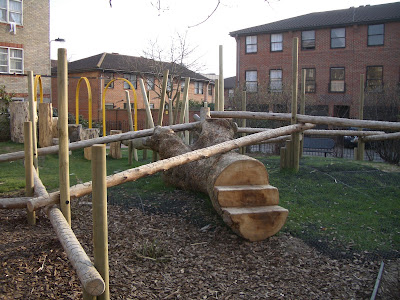
It gives specific attention to children's play and spaces designed for play, and Tim has been instrumental in moving the conversation for new playgrounds in London from a discussion of risk alone to a proper consideration of risk AND benefits as applied to playgrounds.
The issue of fear and risk couldn't have been more evident than at our visit to Elm Village, a pocket park on a housing estate in Camden, to see an installation then but a few weeks old by London-based Theories Landscapes. Just as we were admiring the playscape, we were approached by a woman from the estate who was not only displeased with it, but actively upset about her perception of its 'dangers'.

Soon, we were at the center of a small group with aggressive complaints:
The climbing structure is dangerous. It's too high. You can fall off of it. You can bump your head from underneath. You can fall down on the hill. Kids on top can see into the ground-floor apartment windows. Maybe its ok for older kids but not for younger kids and the big kids will take over the space and be bullies. The sticks on the bushes are sharp and might poke a child in the eye. The kids might enjoy it for a while but they will soon get bored. One of the entrances to the playspace is through the parking lot and someone might get run over. It's ugly.

As we talked however, the attitude of the women softened considerably. They began to acknowledge that the playground was innovative and even attractive, though they still felt that it was somehow unsafe.

It became clear that the problem was largely one of expectations: the installation differed so dramatically from what they had expected; from what they thought a playground, and in particular a 'safe' playground, should look like. Having only experienced conventional commercial equipment installed on pancake flat ground, it had become their standard.
It reminded me that communication becomes extra important when trying to do something new or innovative. The residents acknowledged that they hadn't gone to the planning meetings held at the estate, but still insisted that the playscape wasn't what they 'thought' they were getting.

While it might not have allayed all of their concerns, some simple signage explaining the playground and its goals would have helped. Just a little information about how the bushes and the timbers were important natural elements, that the apple trees on the trellis (along the yellow arches in the pictures) would shield the windows of the ground floor apartments as they grew, and that the incorporation of the hills and the height of the climbers was in line with research about how children needed to be challenged as they played, could have at least helped the moms understand. And if they understood, perhaps they might have felt proud of their unique playspace instead of believing they were simply being experimented on by the council. Perhaps they still can. I wonder what they'll think at this time next year?

While we were talking, a group of children, ranging in age from 5 to 15, came to the playground and began to play together behind us. Quite happily.
No comments:
Post a Comment